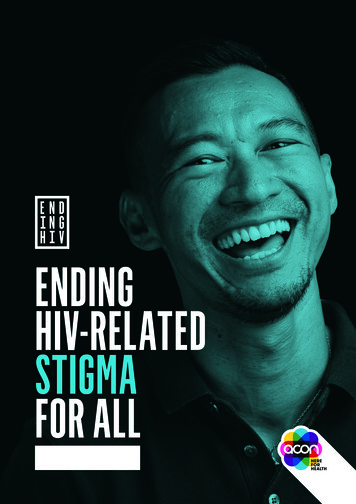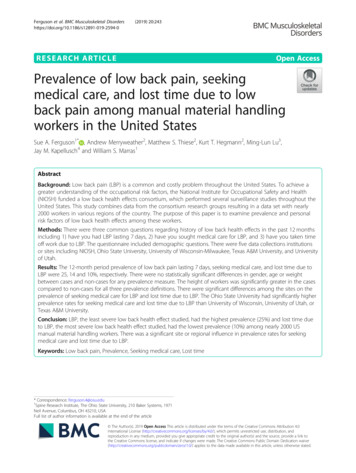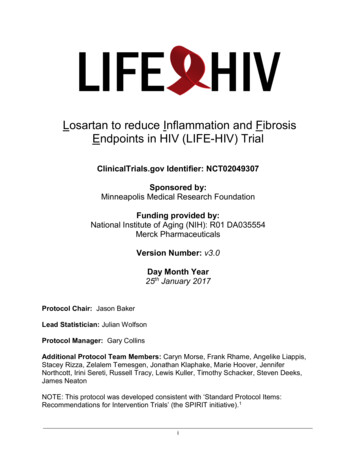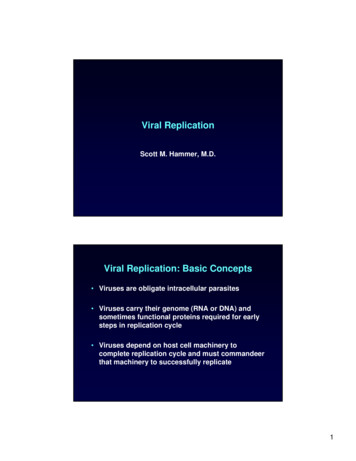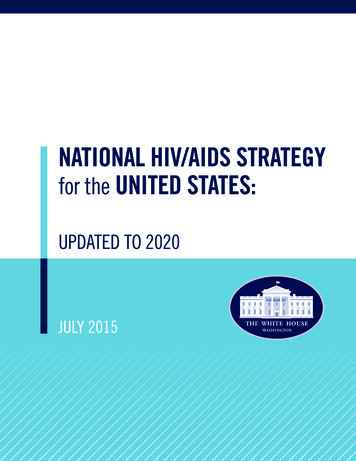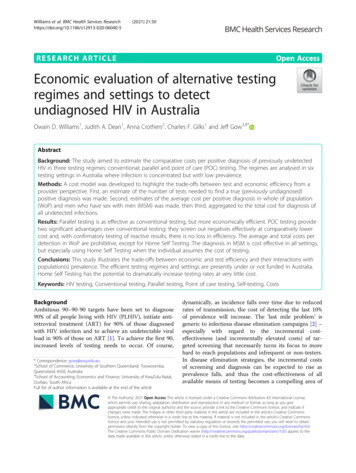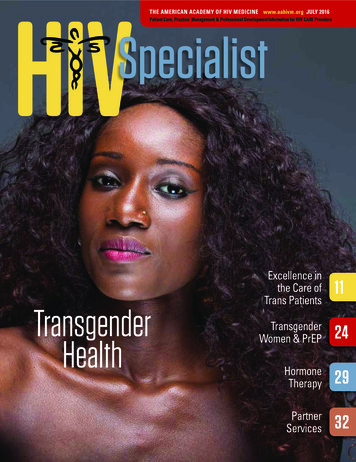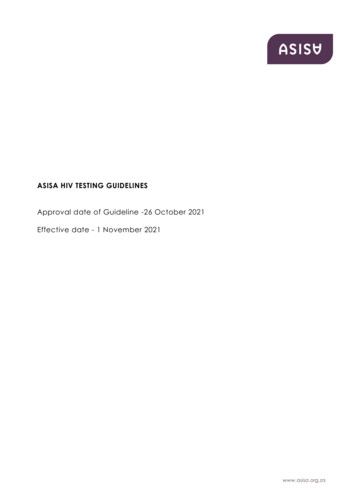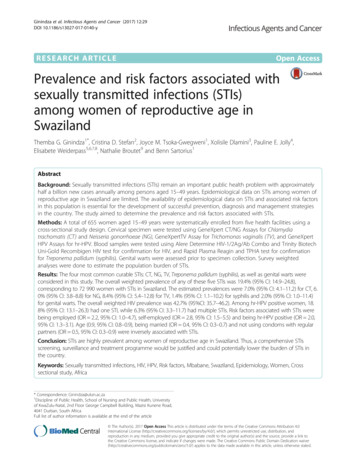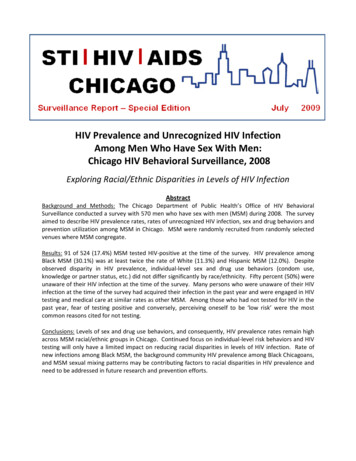
Transcription
HIV Prevalence and Unrecognized HIV InfectionAmong Men Who Have Sex With Men:Chicago HIV Behavioral Surveillance, 2008Exploring Racial/Ethnic Disparities in Levels of HIV InfectionAbstractBackground and Methods: The Chicago Department of Public Health’s Office of HIV BehavioralSurveillance conducted a survey with 570 men who have sex with men (MSM) during 2008. The surveyaimed to describe HIV prevalence rates, rates of unrecognized HIV infection, sex and drug behaviors andprevention utilization among MSM in Chicago. MSM were randomly recruited from randomly selectedvenues where MSM congregate.Results: 91 of 524 (17.4%) MSM tested HIV-positive at the time of the survey. HIV prevalence amongBlack MSM (30.1%) was at least twice the rate of White (11.3%) and Hispanic MSM (12.0%). Despiteobserved disparity in HIV prevalence, individual-level sex and drug use behaviors (condom use,knowledge or partner status, etc.) did not differ significantly by race/ethnicity. Fifty percent (50%) wereunaware of their HIV infection at the time of the survey. Many persons who were unaware of their HIVinfection at the time of the survey had acquired their infection in the past year and were engaged in HIVtesting and medical care at similar rates as other MSM. Among those who had not tested for HIV in thepast year, fear of testing positive and conversely, perceiving oneself to be ‘low risk’ were the mostcommon reasons cited for not testing.Conclusions: Levels of sex and drug use behaviors, and consequently, HIV prevalence rates remain highacross MSM racial/ethnic groups in Chicago. Continued focus on individual-level risk behaviors and HIVtesting will only have a limited impact on reducing racial disparities in levels of HIV infection. Rate ofnew infections among Black MSM, the background community HIV prevalence among Black Chicagoans,and MSM sexual mixing patterns may be contributing factors to racial disparities in HIV prevalence andneed to be addressed in future research and prevention efforts.
BackgroundWell into the third decade of the human immunodeficiency virus (HIV) epidemic, rates of HIV infectionin Chicago remain high, especially among men who have sex with men (MSM). Of 1,557 newlydiagnosed HIV infections in Chicago during 2006, the Chicago Department of Public Health (CDPH)estimates that approximately 62% were among MSM1. Forty-two percent (42%) of these MSMdiagnoses were among Blacks, 36% were among Whites, 17% were among Hispanics and 5% wereamong other races. Through 2006, there were 21,367 persons living with HIV in Chicago; of those,54.7%, or 11,697, were MSM2.To assess sexual and drug use risk behaviors and HIV prevalence among MSM, CDPH analyzed data fromthe National HIV Behavioral Surveillance (NHBS-Chicago) system in Chicago. This report summarizespreliminary findings from the NHBS-Chicago (2008), which indicated that, HIV prevalencea among MSMwas 17.4% (of 524 MSM tested, 91 MSM tested HIV-positive) and that 50% of MSM who tested positivewere unaware of their HIV infection at the time of the survey. This report aims to describe rates of HIVprevalence and of unrecognized infection in detail, and explore the differences in rates amongracial/ethnic groups of MSM in Chicago.MethodsNHBS is a national, ongoing surveillance system that collects cross-sectional data in 21 US cities amongpopulations at high risk for acquiring HIV, including MSM, injection-drug users, and heterosexuals-athigh-risk. This system is known in Chicago as Project CHAT. For the MSM cycle conducted in Chicagoduring 2008, men were sampled systematically from randomly selected venues where MSM congregate(e.g., bars/dance clubs, athletic leagues, professional groups, hobby/special interest organizations,public sex environments, gay pride events, retail stores, and street locations). Formative research wasconducted from January through July 2008 to garner community support, and identify venues, as well asdays and times when MSM frequented these venues. Data collection took place from August throughDecember 2008. Men attending venues were randomly approached and were asked if they wereinterested in participating and undergoing eligibility screening. Men eligible for the survey were aged 18 years and residents of the Chicago metropolitan statistical area (MSA). Using a standardizedquestionnaire, men were interviewed about their sexual and drug-use behaviors, HIV-testing behavior,and use of HIV-prevention services. Eligible participants were also offered HIV testing following thesurvey. Participants were compensated up to 50 for the time and effort required for taking the surveyand HIV test.aHIV prevalence is defined as the proportion of people within a specific population that are currently living with HIV.STI/HIV/AIDS Chicago2July 2009
The OraSure HIV test was used to screen blood specimens for HIV antibodies. Initially-reactivespecimens were tested by Western blot for confirmation at the Illinois Department of Public Healthlaboratories. Participants were asked about the date and result of their most recent HIV test beforebeing tested for HIV as part of NHBS. If a participant reported having tested HIV-positive prior to thesurvey, they were asked the date of their most recent HIV-negative test. Men who had not been HIVtested during the year prior to the survey were asked about their reasons for not testing.ResultsDemographics In Chicago, 669 men sampled from 57 different venues participated in NHBS-Chicago. Atotal of 570 men reported having had one or more male sex partners in the past year. Of these 570participants, the mean age was 32 years (range: 18-70 years); 27% were Black, 44% were White, 22%Hispanic, 3% Asian/Pacific Islander, and 3% reported Multiracial or Other. Overall, respondents in thesample were relatively evenly distributed by annual household income. Twenty-seven percent (27%) ofrespondents had annual incomes between 0 and 19,999, 37% had annual incomes between 20,000and 49,999, and 34% of respondents had incomes over 50,000. The majority (77%) of respondents inthe sample were high-school graduates or higher (Table 1). Each of Chicago’s zip codes wererepresented by at least one survey participant. There were 3 geographical areas of the city thatrepresented the largest concentration of participants: 1) Lakeview/Uptown/Edgewater, 2) AuburnGresham, and 3) Logan Square/ West Town. Fifty-nine respondents (10%) reported residence outsideof the city (Figure 1).STI/HIV/AIDS Chicago3July 2009
TABLE 1. Demographic Characteristics(National HIV Behavioral Surveillance System, Men Who Have Sex With Men, Chicago, August2008 - December 2008) (n n Indian/Alaskan Native2 1Asian173Native Hawaiian/Pacific Islander1 1Other16318 — 241522725 — 342063635 — 441482645 — 5451955 1320 - 19,9991552720,000 – 49,9992133750,000 19134HS Grad or Less13123Some College or Higher43877Race/EthnicityAge (years)Annual Household Income ( )Highest Level of EducationSTI/HIV/AIDS Chicago4July 2009
FIGURE 1. Map of Respondent ZIP Codes of Residence(National HIV Behavioral Surveillance System, Men Who Have Sex With Men, Chicago,August 2008 – December 2008) (n 511)(59 respondents reside outside of city boundaries)STI/HIV/AIDS Chicago5July 2009
Participants were recruited at venues where MSM comprised at least 75% of the attendees. Theseincluded: bars (41%), dance clubs (20%), social organizations (14%), street locations (12%), sexenvironments (6%), gay pride events (5%), and retail stores (3%). Examples of social organizations wereathletic leagues, hobby/special interest group meetings, and church services. Sex environmentsconsisted of bathhouses, parks, beaches, and back rooms of bars where sexual activity took place.Recruitment on sidewalk corridors occurred in areas of the city that are well-known neighborhoodswhere MSM live and congregate.HIV Prevalence Ninety-two percent (92%) of survey participants agreed to be tested for HIV. Of the 524MSM tested for HIV during the 2008 NHBS survey, 91 men tested HIV-positive. Thus, the overall HIVprevalence rate among participants was 17.4%. HIV prevalence increased stepwise by each agecategory. Among MSM 18-24 years of age, the prevalence rate was 13.6%. For those older than 45years of age, the prevalence rate was 22%.The examination of prevalence rates among MSM by race/ethnicity revealed stark disparities betweengroups. The HIV prevalence rate among all Black MSM in the sample was 30.1% (44 positives out of 146tested). This rate was almost three times that of White MSM (11.3%, 26 positives out of 229 tested),and two-and-a-half times that of Hispanic MSM (12.0%, 14 positives out of 117 tested) (Table 2).Reliable prevalence rates were unable to be calculated for other racial/ethnic groups due to the smallnumbers surveyed. The remainder of this report, which aims to explore the implications of theseprevalence rates, will focus only on MSM who reported Black or White race, or Hispanic ethnicity.STI/HIV/AIDS Chicago6July 2009
TABLE 2. HIV Prevalence of Respondents Tested by Race/Ethnicity and Age Category(National HIV Behavioral Surveillance System, Men Who Have Sex With Men, Chicago,August 2008 - December 2008) (n 492)TestedRace/EthnicityHIV nic1171412.0Age (years)(#)(#)(%)18 — 241401913.625 — 341752916.635 — 441202420.0 45571221.1TOTAL4928417.1HIV Prevalence (continued) The racial/ethnic disparity becomes particularly pronounced whencomparing HIV prevalence rates among younger MSM. Thirty percent (30%) of Black MSM under 35years of age tested HIV-positive compared to 4.2% of White MSM and 11.6% of Hispanic MSM in thesame age category (Table 3).STI/HIV/AIDS Chicago7July 2009
TABLE 3. HIV Prevalence of Respondents Tested by Race/Ethnicity by Age Category(National HIV Behavioral Surveillance System, Men Who Have Sex With Men, Chicago,August 2008 - December 2008) (n 492)Total (#)HIV (#)(%)18-24661624.225-34451737.835-4429931.045 45 .045 600.01171412.0BlackBlack Total30.0%WhiteWhite Total4.2%HispanicHispanic TotalSTI/HIV/AIDS Chicago811.6%July 2009
Unrecognized Infection Half of all MSM (50%) who tested positive for HIV during the survey wereunaware of their HIV infection. An individual who was “unaware” of his HIV infection was defined assomeone who tested HIV-positive at the time of survey and had either reported their most recent HIVtest result to be negative, or who reported no lifetime HIV test, or that they did not receive the resultsof their most recent HIV test and have not received a previous positive HIV test result. Sixty-six percent(66%) of Black MSM who tested positive in the sample were unaware of their HIV infection, 50% ofHispanic MSM, and nearly one-quarter of White MSM (23%) were unaware of their HIV infection at thetime of the survey (Table 4).TABLE 4. Respondents Unaware of their HIV Positive Status by Race/Ethnicity(National HIV Behavioral Surveillance System, Men Who Have Sex With Men, Chicago,August 2008 - December 2008) (n 84)Total HIV Unaware HIV %(#)(n 84)(#) (n V Testing and Health Behaviors of MSM Unaware of Their HIV Infection HIV testing behaviors are,overall, similar among MSM who were unaware of their HIV infection and those MSM who tested HIVnegative during the survey. Eighty-eight percent (88%) of the men who were unaware of their HIVinfection had been tested for HIV in their lifetime (compared to 92% of HIV- negative MSM). Sixty-onepercent (61%) of MSM who were unaware of their HIV infection had reported taking at least two HIVtests in the past two years (compared to 67% of HIV negative MSM in the sample) (Table 5).Over half (62%) of MSM who were unaware of their HIV-positive status reported taking an HIV test inthe past 12 months. For the 17 MSM who were unaware of their infection and had not tested in thepast year, the most commonly reported main reason for not testing was that they were, “afraid offinding out the result”. The second most common reason cited was, “I think I’m at low risk for HIV”.STI/HIV/AIDS Chicago9July 2009
None of the MSM who were unaware of their infection reported that they ‘didn’t know where to go toget tested’ as a reason for not getting tested for HIV.The majority of HIV-positive MSM who were unaware of their HIV infection reported being currentlyinsured and were receiving medical care. Sixty percent (60%) of those unaware of their HIV infectionreported currently having some form of health insurance (compared to 72% of HIV-negative MSM),while 82% had reported visiting a health care provider for medical care in the past year (compared to79% of HIV-negative MSM) (Table 5).TABLE 5. HIV Testing and Health Behaviors by HIV Status and Unrecognized HIV Infection(National HIV Behavioral Surveillance System Men Who Have Sex With Men, Chicago,August 2008 - December 2008) (n 475)Unaware HIV NHBS HIV Negative(n 42)(n 433)(%)(%)88922 HIV tests in past 2 years6167Currently insured60728279Ever tested for HIVSeen a health care provider in past 12 monthsRecently Acquired HIV Infection The data on HIV testing behaviors also revealed that a majority ofBlack and Hispanic MSM who were unaware of their HIV infection at the time of the survey likelyacquired their HIV infection within 12 months prior to the survey. Sixty-nine (69%) percent of BlackMSM and 57% of Hispanic MSM who were unaware of their infection tested HIV-negative less than 12months prior to the survey. This compares to 33% of White MSM who reported an HIV-negative testresult within 12 months of the survey (Table 6).STI/HIV/AIDS Chicago10July 2009
TABLE 6. HIV Acquisition in the past 12 Months among HIV Men Unaware of Their Infection(National HIV Behavioral Surveillance System, Men Who Have Sex With Men, Chicago,August 2008 - December 2008) (n 42)Total UnawareHIV (#)Infected in Past12 Months%(n exual Risk Behaviors of HIV-negative and MSM Unaware of Their HIV Infection After excluding MSMwho reported being HIV-positive, 449 MSM participants reported a median number of three male sexpartners in the 12 months prior to the survey. This value was identical between Black, White andHispanic MSM. Approximately half (51%) of these MSM reported engaging in unprotected analintercourse (UAI) with a male partner in the past 12 months; there was virtually no difference betweenBlack, White and Hispanic MSM in this respect. Overall, almost one-third of MSM reported not knowingthe HIV status of their most recent sex partner (32%). Thirty-nine percent (39%) of MSM reportedconcurrent (overlapping) sexual relationships with two or more men including their most recent malesex partner. Neither of these risk behaviors differed significantly in frequency by race/ethnicity. Drugand alcohol use occurred before or during the most recent sexual encounter with a male in less than half(41%) of MSM, with no apparent differences by race/ethnicity (Table 7).STI/HIV/AIDS Chicago11July 2009
TABLE 7. Sexual Risk Behaviors by Race/EthnicityAll MSM, Excluding Men Who Are Aware of Their HIV Infection(National HIV Behavioral Surveillance System, Men Who Have Sex With Men, Chicago,August 2008 - December 2008) (n 449)All MSM excluding thoseaware of their HIV infectionBlack(n 112)White(n 225)Hispanic(n 112)TOTAL(n 449)(%)(%)(%)(%)Unprotected anal sex with aman - past 12 months50495452Don’t know HIV status ofmost recent sex partner38263633Drug and/or alcohol usebefore or during most recentsex40394340Concurrent sexual partners38394343# Male sex partners (medianpast 12 months)3333Sexual Risk Behaviors of HIV-negative and MSM Unaware of Their HIV Infection (continued) YoungerWhite MSM (less than 35 years of age) had a median of 4 male sex partners in the past 12 months,compared to 2 partners among younger Hispanic MSM, and 3 partners among younger Black MSM.Similar to older MSM, there were no other significant differences reported between racial/ethnic groupsfor the analyzed sexual risk behaviors (Table 8).STI/HIV/AIDS Chicago12July 2009
TABLE 8. Sexual Risk Behaviors by Race/EthnicityMSM under the age of 35 Years, Excluding Men Who Are Aware of Their HIV Infection(National HIV Behavioral Surveillance System, Men Who Have Sex With Men, Chicago,August 2008 - December 2008) (n 293)BlackWhiteHispanicTOTAL(n 99)(n 114)(n 80)(n 293)(%)(%)(%)(%)Unprotected anal sex with a man past 12 months50555654Didn’t know HIV status of mostrecent sex partner34253130Drug and/or alcohol use before orduring most recent sex38374640Concurrent sexual partners45423642# Male Sex Partners(median past 12 months)3423All MSM under 35 years of age(excluding those aware of their HIVinfection)Sexual Risk Behaviors of MSM Unaware of Their HIV Infection The 42 MSM who were unaware of theirHIV infection reported higher rates of unprotected anal sex and lower rates of knowledge of most recentpartner’s HIV status than HIV-negative MSM. Variations were observed across race/ethnicity. AmongBlack MSM, 59% did not know the status of their most recent male sex partner compared to 33% ofWhite MSM and 43% of Hispanic MSM. At the same time, White MSM were more likely to be havingconcurrent sexual relationships than either Black or Hispanic MSM (67% vs. 41% and 29%, respectively)(Table 9).STI/HIV/AIDS Chicago13July 2009
TABLE 9. Sexual Risk Behaviors of Men Who Are Unaware of Their HIV Status by Race/Ethnicity(National HIV Behavioral Surveillance System, Men Who Have Sex With Men, Chicago,August 2008 - December 2008) (n 42)MSM Unaware of their HIVInfectionBlack(n 29)White(n 6)Hispanic(n 7)TOTAL(n 42)(%)(%)(%)(%)Unprotected anal sex with aman - past 12 months59674357Didn’t know HIV status of mostrecent sex partner59334352Drug and/or alcohol use beforeor during most recent sex31334333Concurrent sexual partners41672943# Male Sex Partners(median past 12 months)3323Sexual Risk Behaviors of MSM Aware of Their HIV Infection A total of 42 MSM were diagnosed with HIVprior to the survey and were aware of their infection at the time of the survey. Over half of these MSM(52%) reported that their most recent male sex partner was either of negative or unknown status. Thisrate was similar by the three race/ethnicity groups (Table 10). Among the 22 men, unprotected anal sexwith a man in the last 12 months was at least twice as common among Hispanic MSM compared withBlack and White MSM (50% compared with 13% and 30% respectively). Concurrent sexual relationshipsoccurred among 50% of both White and Hispanic men in this group, while it occurred among only 25%of Black MSM. Drug and alcohol use before or during sex varied widely between races within this group.Seventy percent (70%) of White HIV-positive men with a sex partner of negative or unknown HIV statusreported drug or alcohol use before or during sex. This compared with 25% of Hispanic MSM and 38% ofBlack MSM (Table 11).STI/HIV/AIDS Chicago14July 2009
TABLE 10 - Men Aware of Their HIV Infection Who Report Having Sex with HIV-Negative Men(National HIV Behavioral Surveillance System, Men Who Have Sex With Men, Chicago,August 2008 - December 2008) (n 42)MSM Aware of HIV InfectionMost Recent Sex PartnerHIV-Negative or UnknownBlack(n 15)White(n 20)Hispanic(n 7)(%)(%)(%)535057TABLE 11 - Sexual Risk Behaviors of Men Aware of Their HIV InfectionWho Report Having Sex with HIV-Negative Men(National HIV Behavioral Surveillance System, Men Who Have Sex With Men, Chicago,August 2008 - December 2008) (n 22)MSM Aware of HIV InfectionBlackWhiteHispanic(n 8)(n 10)(n 4)(%)(%)(%)Unprotected anal sex133050Drug and/or alcohol usebefore or during sex387025Concurrent sexual partners255050Most Recent Sex PartnerHIV-Negative or UnknownDrug Use Illicit drug use was reported among approximately half (49%) of all MSM. Polydrug use wasless common among Black MSM than White or Hispanic MSM (15% among Black vs. 27% among bothWhite and Hispanic MSM). Black MSM were also less likely to use club drugs (i.e. ketamine, GHB),crystal methamphetamine, painkillers (e.g. Oxycontin), powdered cocaine, or poppers than White orHispanic MSM. Crystal meth use was reported among 7% of White and Hispanic MSM and only 1% ofBlack MSM. The rate of powdered cocaine use among White MSM was two times greater than it wasamong Black or Hispanic MSM (15% vs. 5% and 6% respectively). Popper use was at least four timesgreater among White and Hispanic MSM than it was among Black MSM (21% and 18% vs. 4%)(Table 12).STI/HIV/AIDS Chicago15July 2009
However, Black MSM reported similar or higher rates of use among three drugs, as compared to WhiteMSM or Hispanic MSM: crack cocaine, ecstasy, and marijuana. Black MSM were also more likely toreport illicit drug use before or during sex than White and Hispanic MSM (13% vs. 8% and 9%,respectively). Marijuana seemed notably associated with sex among Black MSM compared to White andHispanic MSM, as 12% of Black MSM reported its use with sex, compared to 4% of White MSM and 5%of Hispanic MSM (Table 12).TABLE 12. Overall Drug Use Behaviors in the Past 12 Months by Race/Ethnicity(National HIV Behavioral Surveillance System, Men Who Have Sex With Men, Chicago,August 2008 - December 2008) (n 445)Black(n 131)White(n 205)Hispanic(n 109)(%)(%)(%)Any illicit drug use474948Polydrug Use152727041Crystal Methamphetamine165Downers/Painkillers285Powder Cocaine51418Poppers (Amyl Nitrate)42118Crack Cocaine325Ecstasy984Marijuana444043Club Drugs(i.e. Gamma Butyrolactone (GHB) and KetamineHydrochloride (e.g Special K, Vitamin K))Alcohol Use The use of alcohol remains nearly ubiquitous among MSM, with 94% of all MSM reportingsome use in the past year. More Black MSM reported no drinking in the past 12 months (10%) thaneither White (3%) or Hispanic MSM (5%). Similarly, excessive drinking (5 or more drinks at least once aweek) was less common among Black MSM, than Whites or Hispanics (22% vs. 37% and 43%,respectively). However, drinking alcohol in conjunction with sex was similarly common between allthree racial/ethnicity groups. Thirty-six percent (36%) of Black MSM reported drinking alcohol beforemost recent sex compared to 38% of White MSM and 42% of Hispanic MSM (Table 13).STI/HIV/AIDS Chicago16July 2009
TABLE 13. Frequency of Alcohol Use by Race/Ethnicity(National HIV Behavioral Surveillance System, Men Who Have Sex With Men, ChicagoAugust 2008 - December 2008) (n 445)Black(n 131)White(n 205)Hispanic(n 109)(%)(%)(%)Drank Alcohol in past year909694Mean number of times had 5 drinks inthe past 30 days345Had 5 drinks (on average) at least oncea week in the past 12 months193440Used alcohol before or during mostrecent sex363940DiscussionThis study provides for the first time, population-based estimates of HIV prevalence among MSM inChicago and offers us an important piece of information to integrate into current communityeducational efforts and a baseline from which to monitor future trends.Consistent with previous and concurrent studies of MSM conducted in other US cities using similarsampling methods these data revealed that3-9: Prevalence of HIV infection among MSM is highBlack MSM had markedly higher prevalence rates than either White or Hispanic MSM, especiallyamong those under 35 years of ageMany HIV-infected MSM, particularly Black and Hispanic MSM, were unaware that they were HIVinfected at the time of the surveyAmong Black MSM with unrecognized infection, at least two-thirds acquired HIV during thepreceding yearOf those who were unaware of their HIV infection and had not been tested recently, many reporteda fear of testing positive or conversely, they did not consider themselves to be at risk.STI/HIV/AIDS Chicago17July 2009
The level of HIV infection among MSM is significantly higher than other groups at risk for HIV in Chicago.In 2007, NHBS-Chicago found the HIV prevalence rate among heterosexual males and females from atrisk Chicago neighborhoods to be 1.8% (14 positives of 759 tested). HIV prevalence rates for injectiondrug users (IDU) surveyed as part of NHBS-Chicago in 2005 was estimated to be between 8 and 10%.Also, CDPH has estimated that in 2008, the HIV prevalence rate among the general male population inChicago was 1.2%1. The overall prevalence rate of HIV infection among Chicago MSM, 17.4%, as foundin this study, complements CDPH HIV case surveillance data that show MSM continuing to make up themajority of new HIV diagnoses and of persons living with HIV in Chicago. In 2006, 951 of 1,557 new HIVdiagnoses in Chicago were among MSM and of the 21,367 cases of HIV and/or AIDS living in Chicago,approximately 11, 697 were MSM2.In an attempt to explain the significant and sobering racial/ethnic disparities in HIV prevalence, wecompared individual-level risk factors among at-risk MSM that are typically associated with HIVacquisition (sexual and drug use behaviors). Overall, traditional sexual and drug use behaviors (includingdrug use before or during sex) remain high among MSM surveyed. Over half (54%) of all MSM reportedhaving sex without a condom in the past year, while one-third reported not knowing the HIV status oftheir most recent male sex partner. Concurrent sexual relationships remain prevalent among manyMSM with just under half (43%) of all MSM reporting being involved in this type of relationship at thetime of the survey. Having sex while high or drunk was also reported frequently (43%), and MSMreported a median (average) of 3 male sex partners in the 12 months prior to the survey. However,Black MSM did not report any differences in sexual risk behaviors or number of recent sex partners thatmight help to readily explain the significant disparity in levels of HIV infection.In general, illicit drug use was reported less frequently among Black MSM than White or Hispanic MSM.Also, unlike White and Hispanic MSM, the vast majority of Black MSM who reported using an illicit drughave used only a single type of drug in the past year, rather than polydrug use. The use of drugs such ascrystal methamphetamine, powdered cocaine, and amyl nitrates (poppers) remains high among Whiteand Hispanic MSM, especially compared to Black MSM. These drugs, in particular, have been associatedwith high-risk sexual behaviors and HIV acquisition in previous studies10. However, the relationship ofdrugs such as ecstasy (MDMA) and marijuana, (the latter being more frequently used by Black MSMbefore or during sex than White or Hispanic MSM), to high-risk sexual behaviors needs furtherexploration. The role of alcohol use in conjunction with sexual decision-making among MSM also needselucidation.The sexual behaviors of HIV-positive men who are aware of their infection are particularly important inunderstanding the spread of HIV and perhaps in explaining the observed disparities in prevalence rates.It has been shown that a person who has been diagnosed with HIV will significantly modify theirbehaviors to protect their sex partners and themselves11. In our sample, Black MSM with knowninfection reported significantly lower rates of sexual risk behaviors compared to the rates among HIV-STI/HIV/AIDS Chicago18July 2009
negative Black MSM. In contrast, among White and Hispanic MSM with known infection, rate ofunprotected anal sex were only slightly lower than their HIV-negative counterparts. Reported drug usebefore or during sex and concurrent sexual relationships among White and Hispanic MSM with knowninfection were more commonly reported when compared to HIV-negative MSM within each of theirrespective racial/ethnic groups.Overall differences in sexual and drug risk behaviors by race/ethnicity, as described above, however, dolittle to account for the 2 to 3-fold differences found in HIV prevalence rates of Black MSM as comparedto White or Hispanic MSM. Despite comparable rates of unprotected anal intercourse (UAI), having sexwith partners of unknown status, numbers of annual sex partners, and illicit drug use, the prevalence ofHIV is found to be far greater among Black MSM than White or Hispanic MSM.So What Might Explain Racial/Ethnic Disparities?While traditional, individual-level risk factors fail to account for the stark disparities in levels of HIVinfection between racial/ethnic groups, broader explanations for this difference must be sought. Whilespecific elements of the following discussion remain largely outside the scope of NHBS data, there arethree factors that have been increasingly gaining attention as explanations for these disparities. Thefollowing three factors will be explored below: 1) the role of new infections; 2) background communityprevalence; and 3) the role of sexual networks.1) The Role of New InfectionsHIV incidenceb can have a profound influence on overall rates of prevalence in a population. Data, fromother studies, have shown that even a small rise in the rate of new infections in a population can havean exponential effect on the total number of overall infections in that population12. Chicago NHBS datasuggest that many HIV-positive MSM have acquired their infections within the last year (Table 14). Atleast 32% of all the HIV-positive MSM participants were indicative of a newly-acquired infection. AmongHIV Black MSM, 46% of the infections were new, compared to 8% of infections among Whites and 29%among Hispanics. In addition, Black MSM also reported being recently diagnosed with HIV morefrequently than White or Hispanic MSM. Rates of recent HIV diagnoses are often used as a supportingindicator for assessing newer infections. Among Black MSM who had been diagnosed with HIV prior tothe survey, over a quarter of these diagnoses (27%) took place within the past 12 months. Bycomparison, only 10% of White MSM and 14% of Hispanic MSM had been diagnosed in the past year. InbIncidence is defined as the number of new HIV cases within a specific popul
Highest Level of Education HS Grad or Less 131 23 Some College or Higher 438 77 TABLE 1. Demographic Characteristics (National HIV Behavioral Surveillance System, Men Who Have Sex With Men, Chicago, August . Among MSM 18-24 years of age, the prevalence rate was 13.6%. For those older than 45 years of age, the prevalence rate was 22%.
